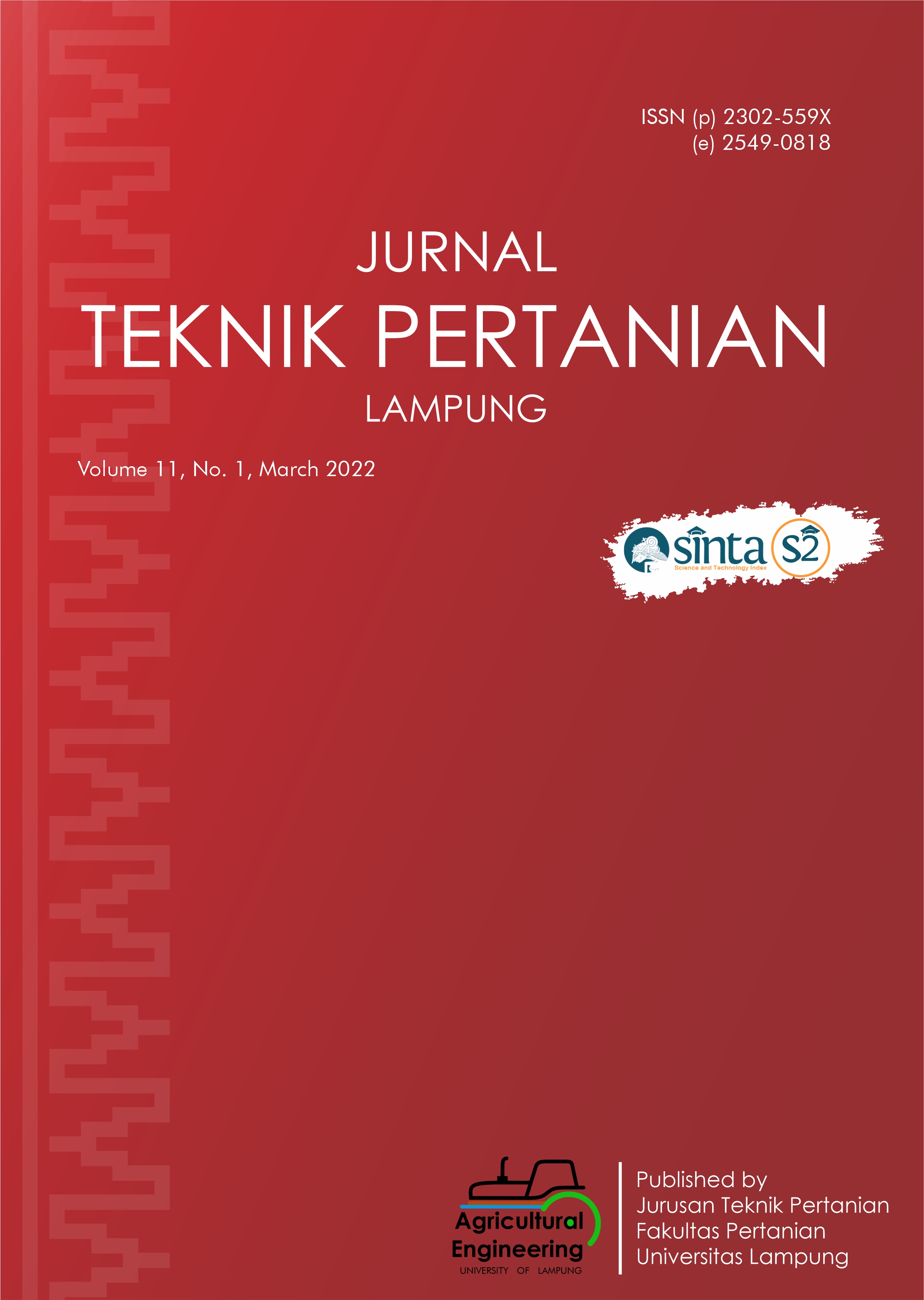The Effect of Bacillus subtilis Bacteria Concentration on Production and Characterization of Pektinase Enzymes from Pineapple Peel Waste (Ananas comosus L. Merr)
DOI:
https://doi.org/10.23960/jtep-l.v11i1.60-69Abstract
This study aims to determine the effect of treatment concentrations (4%; 8%; 10%; 13%; 16%; 20%) of Bacillus subtilis bacterial isolates on the production of pectinase enzymes from pineapple peel waste, and the characteristics of the pectinase enzyme produced include (enzyme activity, optimum temperature, optimum pH, Km and Vmax values). The yield of crude enzyme extract production from the 6 treatments carried out, the highest yield was found in the 10% treatment at 1.59 g and the lowest in the 4% treatment at 1.53 g. In the results of enzyme characterization, the highest enzyme activity was found at a concentration of 20% at 1.883, and the pectinase enzyme produced was able to work optimally in environmental conditions with a temperature of 400C and pH 4 at all concentrations, but the highest activity at variations in temperature and pH was on enzymes with 20% bacterial concentration treatment, namely 0.680 at 400C and 0.650 at pH 4. Enzyme kinetics analysis obtained from the pectinase enzyme produced, showed the highest Km value of 0.021 at a concentration of 4% while the lowest value is 0.0095 at a concentration of 20%. Then at the Vmax value of the enzyme, the highest value was found at the 20% concentration treatment and the lowest value was at 4% treatment was 0.481.
Keywords: Bacillus subtilis, Characterization, Enzyme Production, PektinaseEnzyme
References
Banik, S & Ghost, S. N. (2008). Pectinolytic Activity of Microorganisms in Piling of Jute. Indian journal of Fibre & Textile Research Vol.33, June 2008,pp. 151-156.
Bintang, M. (2010). Biokimia Teknik Penelitian. PT. Gelora Aksara Pratama. Jakarta.
Buga. (2010). Partially purified polygalacturonase from Aspergillus niger SA6. Afr J Biotechnol. 9(52):8944-8954.
Cai, C., B. Lou & X. Zheng. (2008). Keratinase Production and Keratin Degradation by Mutant Strains of Bacillus subtilis. Journal of Zhejiang University Science B. 9, 60-67.
Dixit, S., Upadhyay, S. K., Singh, H., Pandey, B., Chandrashekar, K., Verma, P. C. (2013). Pectin-methylesterase of Datura Species, Purification, and Characterization from Datura stramonium and Aplication. Plant Signaling and Behavior. 8: 1-7.
Fardiaz, S. (1992). Biotransformation Inorganic Reaction. Jakarta: PT. Gramedia Pratama Utama.
Fox, P. F. (1991). Food Enzymology. Vol. 1. Elsevier Applied Science Publishers Ltd., London.
Hames BD, Hooper NM. (2000). Biochemistry: The Instant Notes. Ed.ke-2. Hongkong:Springer-Verlag.
Jayani R. S., Saxena & Gupta R. (2005). Microbial Pectinolytic Enzymes a Review. Journal Biochem.
Kashyap DR, Chandra S, Kaul A, Tewari R. (2000). Production, purification and characterization of pectinase from a Bacillus sp. DT7. World J Microbiol Biotech. 16: 277-282.
Rangarajan, V., Rajasekharan, M., Ravichandran, R., Sriganesh, K., Vaitheeswaran, V. (2010). PektinaseProduction from Orange Peel Extract and dried Orange Peel Solid as Substrate using Aspergilus niger. International Journal of Biotech and Biochem, 6(3): 445-453.
Sierio, C. (2012). Microbial Pectic Enzymes in the Food and Wine Industry. Food Industrial Processes Methods and Equipment.
Sittidilokratna, C., Suthirawuta, S., Chitradona, L., Punsuvonc, V., Vaithanomsatb, P., Siriachab, P. (2007). Screening of PektinaseProducing Bacteria and Their Efficiency in Biopulping of Paper Mulberry Bark. Sci Asia 33: 131-135.
Whitaker, J. R. (1996). Enzymes. In O. R. Fenenema (Ed.). Food Chemistry. 3rd Edition. Maecel Dekker, Inc., New York.
Widowati, E., Utami, R., Nurhartadi, E., Andriani, M., Hanifah, R. (2014). Produksi Dan Karakterisasi Enzim Pektinase Bakteri Pektinolitik Dari Limbah Kulit Jeruk Untuk Klarifikasi Jus Lemon (Citrus limon). Jurnal Teknologi Hasil Pertanian, Vol. VII, No. 1
Wiseman, A. (1989). Handbook of Enzymes Biotechnology. 2nd Edition. Ellis Howard, New York.
Downloads
Published
Issue
Section
License
- Authors who publish with this journal agree to the following terms:
- Authors retain copyright and grant the journal right of first publication with the work simultaneously licensed under a Creative Commons Attribution-ShareAlike 4.0 International Lice that allows others to share the work with an acknowledgement of the work's authorship and initial publication in this journal.
- Authors are able to enter into separate, additional contractual arrangements for the non-exclusive distribution of the journal's published version of the work (e.g., post it to an institutional repository or publish it in a book), with an acknowledgement of its initial publication in this journal.
- Authors are permitted and encouraged to post their work online (e.g., in institutional repositories or on their website) prior to and during the submission process, as it can lead to productive exchanges, as well as earlier and greater citation of published work (See The Effect of Open Access).
Jurnal Teknik Pertanian Lampung

JTEPL is licensed under a Creative Commons Attribution-ShareAlike 4.0 International License.

